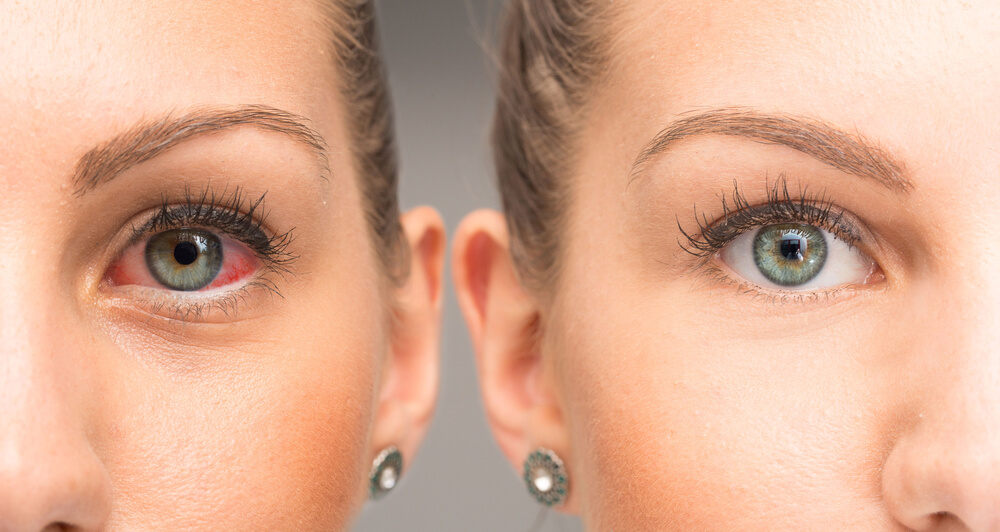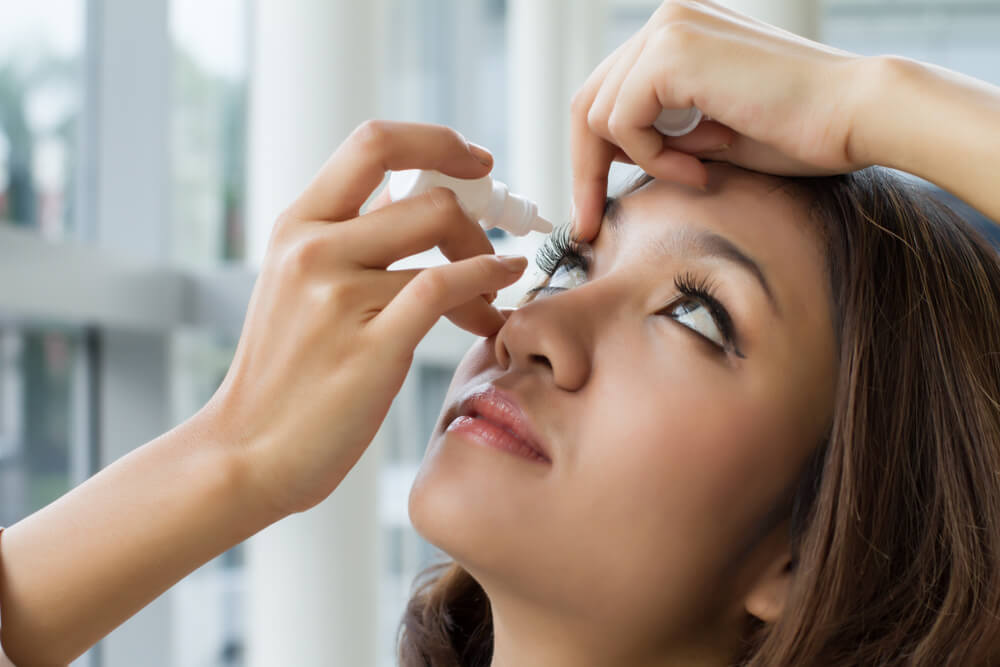
Dry eye syndrome is a common eye condition that many people experience worldwide. Our dedicated and knowledgeable eye doctors at Missouri Eye Institute specialize in diagnosing and treating dry eye and can help you improve your dry eye symptoms.

The cornea is the clear, dome-shaped window at the front of your eye. In order for it to be healthy, it must be properly lubricated and moisturized.
Your tears are responsible for maintaining the proper moisture balance to keep your cornea healthy. If your cornea is not adequately lubricated, you will experience dry eye symptoms–these include irritation, burning, tearing, and blurry vision.
When you blink, a film of tears spreads over your eye. The tear film nourishes and protects the eye by washing away particles in the eye. The tear film also keeps the surface of the eye smooth, providing clear vision. Glands in and around the eyelid are responsible for producing the components that make up the tear film.
A healthy tear film has three layers: lipid, aqueous, and mucin. Each tear film component serves a different purpose, and they all must be appropriately balanced for your tears to be of good quality.
The outside layer of the tear film is the lipid layer and it consists of oil. This layer smooths the surface of your eye and keeps tears from evaporating.
The tiny glands that produce this oil are called the meibomian glands. They are located at the ends of your eyelids, near your eyelashes.
When your meibomian glands are clogged or blocked, they cannot release oil. If your meibomian glands do not release an adequate amount of oil, it can negatively impact your tear quality and cause dry eye.
This condition is called meibomian gland dysfunction, or MGD.
The middle of the tear film is the aqueous layer, and it is made of water. The aqueous layer bathes and cleans the eye, washing away dirt and foreign particles.
The lacrimal glands are responsible for producing the water for the aqueous layer. This layer is the largest and also helps prevent infection.
The mucin layer is the inside of the tear film, closest to your cornea. The mucin layer is made of mucus.
This layer keeps the eye’s surface moist by ensuring that the aqueous layer is spread evenly across the eye. This mucus is sticky and adheres the tears to the cornea to help maintain lubrication.
Tiny cells called goblet cells on the eye’s surface are responsible for producing the mucus for this layer. Various factors can cause decreased tear production or inadequate quality tears.
Each tear film layer must do its part to prevent the cornea from drying out. For your eye to be adequately lubricated, each layer must prevent evaporation, cleanse the eye, and spread moisture evenly.
Various factors can contribute to the development of dry eye syndrome. Finding the root cause of your dry eye is essential to determining a treatment plan to improve your symptoms.
The best way to figure out what is causing your dry eye is by visiting your eye doctor for a thorough exam. Once they have determined why your eyes are dry, they can then develop a treatment plan.
Age is a risk factor for developing dry eye syndrome. The condition is also more common in women due to hormonal changes brought on by pregnancy, oral contraceptive use, and menopause.
Certain health conditions, including rheumatoid arthritis, diabetes, Sjögren’s syndrome, thyroid disease, and lupus, have been shown to increase dry eye symptoms. Some medications like antihistamines, decongestants, and antidepressants can reduce tear production, leading to dry eye disease.
You may experience dry eye syndrome if you have other eye conditions such as blepharitis or eyelids that turn in or out. Additionally, if you spend a lot of time using a computer or digital device, you may also experience dry eye symptoms because you don’t blink as often when focusing on a screen or digital device. Decreased blinking can reduce the lubrication of your cornea and cause dry eye symptoms.
Other contributors to dry eye include extended wearing times of contact lenses, environmental conditions like exposure to smoke and wind, or a very dry climate.
The symptoms presented in dry eye syndrome can vary from person to person. The most common symptoms of dry eye syndrome are stinging, burning, scratchiness, and irritation of your eyes.
Many people also experience excessive tearing. If your tears’ oil and mucus layers are insufficient, the tears will not provide enough moisturization.
If they do not stay on the cornea to lubricate it, they will fall off the eye, and you will experience increased tearing. Some people also notice sensitivity to light or wind and fluctuating blurry vision.
Your eye doctor at Missouri Eye will begin your dry eye evaluation by completing several tests. They will look at the condition of your eyelids, the surface of your eye, and the quality of your blink.
After your eye doctor gathers all the information, they will be able to determine what is the root cause of your dry eye. Your eye doctor will also be able to tell how severe your dry eye is based on these results.

If your dry eyes are bothering you, completing at-home treatments may help you find some relief. Try some of the following:
Your eye doctor may recommend doing warm compresses with heat masks designed to provide sustained heat and moisture to the eyes.
Artificial tears are lubricating eye drops that supplement natural tear production. Dry eyes that don’t respond to artificial tears will need additional treatment.
Sometimes at-home treatments will not solve all of your dry eye symptoms. If this is the case, it may be time to visit your eye doctor.
At Missouri Eye Institute, we offer a variety of in-office treatments that can help improve your dry eye symptoms.
The iLux® is a handheld medical device that your eye doctor can use to help restore the release of oil that may be clogged in your meibomian glands. First, your eye doctor will examine the meibomian glands in your eyelid.
Your eye doctor will then be able to see if there are any blockages in your meibomian glands. For those with MGD (meibomian gland dysfunction), the meibomian glands are not producing the proper amount of oil to keep the cornea lubricated.
The iLux® treatment can restore the normal oil flow from your glands and improve your dry eye symptoms. Treatment with the iLux® is fast, easy, and non-invasive.
Using the Systane iLux® MGD Thermal pulsation device, gentle warming and pressure can be delivered directly to your eyelids. The gentle warmth and massage can unblock meibomian glands in as little as eight to twelve minutes for both eyes.
Potential side effects may include eyelid/eye pain requiring stopping the treatment procedure, eyelid/eye irritation or inflammation, temporary reddening of the skin, and other eye symptoms (burning, stinging, tearing, itching, discharge, redness, feeling like there is something in the eye, changes in your vision, sensitivity to light).
AB Max™ is a medical device that enables your eye doctor to clean the bacteria and buildup that causes anterior blepharitis. Anterior blepharitis is an inflammation of the outside front of the eyelid where your eyelashes attach to your eyelid. Anterior blepharitis can happen due to bacteria on your skin.
Regular treatments with the AB Max™ can help ward off the bacteria that causes blepharitis and soothe your symptoms.
Punctal plugs are tiny collagen or silicone plugs inserted into your tear ducts to partially block tear drainage. When tears are able to stay on the surface of your eyes longer, moisturization of your cornea will increase and lessen your dry eye symptoms.
Your eye doctor may recommend punctal plugs if you experience excessive tearing. They can place punctal plugs into your tear ducts during an in-office visit.
Many eye doctors use prescription medication to treat chronic dry eyes. There are many different types of medicated eye drops that can treat the root cause of certain types of dry eye.
When artificial tears do not seem to be adequately improving your symptoms, your eye doctor may recommend starting prescription eye drops. Prescription eye drops can help improve the quality of your tears, leading to improved dry eye symptoms.
Are you ready to get help to improve your dry eye symptoms? Schedule a dry eye consultation at Missouri Eye Institute today!
Springfield
1531 E Bradford Parkway Ste 100
Springfield, MO 65804
Branson
1000 James F. Epps Rd Ste 2
Branson, MO 65616
Joplin
4500 E 32nd St
Joplin, MO 64804